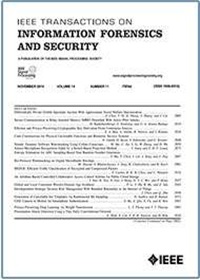MBBFAuth: Multimodal Behavioral Biometrics Fusion for Continuous Authentication on Non-Portable Devices
IF 6.3
1区 计算机科学
Q1 COMPUTER SCIENCE, THEORY & METHODS
IEEE Transactions on Information Forensics and Security
Pub Date : 2024-10-14
DOI:10.1109/TIFS.2024.3480363
引用次数: 0
Abstract
Continuous authentication based on behavioral biometrics is effective and crucial as user behaviors are not easily copied. However, relying solely on one behavioral biometric limits the accuracy of continuous authentication. Therefore, a continuous authentication system based on multimodal behavioral biometrics fusion is proposed in this study, which fuses three modalities: contextual behavior, mouse behavior, and information interaction behavior. The multimodal dataset of user behavior is collected through a self-built website, and the behavioral feature sets for each modality are then created. An improved generative adversarial network method is used to align the datasets of the three modalities. The autoencoder with long short-term memory is employed for unsupervised anomaly detection of time-series behaviors and enables continuous authentication for each modality. The multimodal fusion is achieved using the meta-model of the stacked generalization method, and the final decision for continuous authentication is then determined. The experimental results demonstrate that the proposed multimodal fusion method significantly outperforms the unimodal and provides an effective way to improve the accuracy and user-friendliness of continuous authentication. This study offers insights into user behavior analysis, behavioral anomaly detection, and multimodal behavior fusion.MBBFAuth:融合多模态行为生物识别技术,实现非便携式设备上的连续身份验证
基于行为生物识别技术的连续身份验证非常有效和重要,因为用户行为不易被复制。然而,仅仅依靠一种行为生物识别技术会限制连续身份验证的准确性。因此,本研究提出了一种基于多模态行为生物识别融合的连续身份验证系统,它融合了三种模态:上下文行为、鼠标行为和信息交互行为。用户行为的多模态数据集通过自建网站收集,然后创建每种模态的行为特征集。使用改进的生成对抗网络方法对三种模式的数据集进行配准。利用具有长短期记忆的自动编码器对时间序列行为进行无监督异常检测,从而实现对每种模态的连续认证。使用堆叠泛化方法的元模型实现多模态融合,然后确定连续认证的最终决策。实验结果表明,所提出的多模态融合方法明显优于单模态方法,为提高连续身份验证的准确性和用户友好性提供了有效途径。这项研究为用户行为分析、行为异常检测和多模态行为融合提供了启示。
本文章由计算机程序翻译,如有差异,请以英文原文为准。
求助全文
约1分钟内获得全文
求助全文
来源期刊

IEEE Transactions on Information Forensics and Security
工程技术-工程:电子与电气
CiteScore
14.40
自引率
7.40%
发文量
234
审稿时长
6.5 months
期刊介绍:
The IEEE Transactions on Information Forensics and Security covers the sciences, technologies, and applications relating to information forensics, information security, biometrics, surveillance and systems applications that incorporate these features
 求助内容:
求助内容: 应助结果提醒方式:
应助结果提醒方式:


